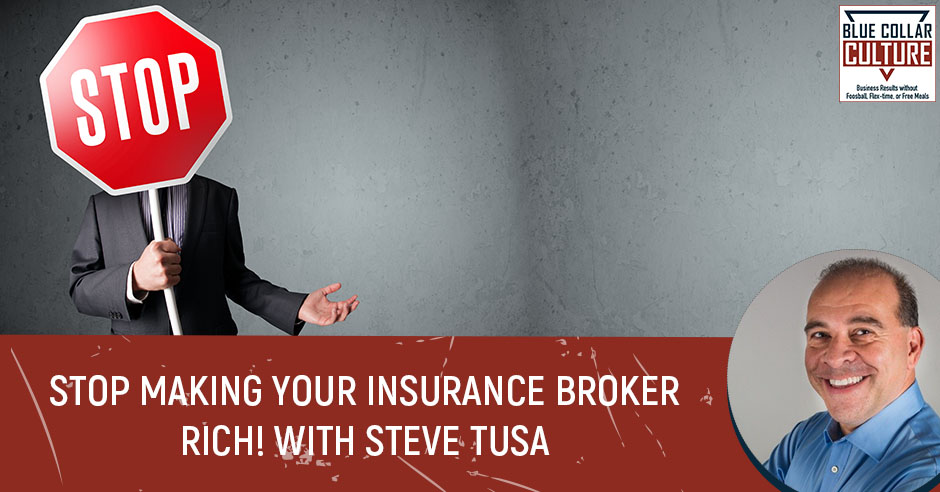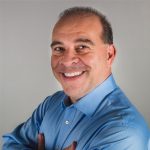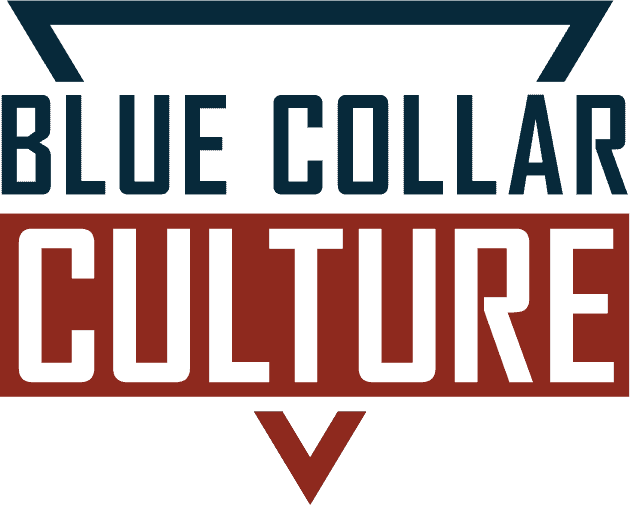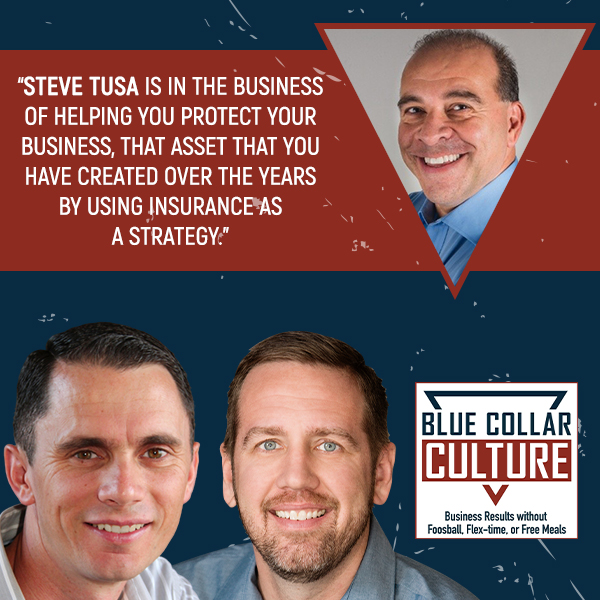
Increased risk comes with growth, which also means an increased financial burden on the organization. Insurance is supposed to help ease that burden, which means you need an insurance broker, right? Well, in this episode, we shatter that and several other myths about insurance. Our hosts Ryan Englin and Jeremy Macliver sit down and tackle the thorny issue of insurance with Reseco COO, Steve Tusa. Steve answers the important questions head-on and gives an insider’s look at what you need to know when it comes to business insurance and risk management. Listen in to learn more about how insurance policies can be made to work in your favor.
—
Stop Making Your Insurance Broker Rich! With Steve Tusa
We spend a lot of time talking about business growth and what we are doing to hire and engage the right people so that they can go out and take care of our customers. One of the things that is a by-product of growing your team is that it comes with increased risk and a lot of times with an increased financial burden to the organization. I am excited about our guest here because he is in the business of helping you protect your business, that asset that you have created over the years. I would love to welcome to the show the Chief Operating Officer of Reseco Insurance Advisors, Steve Tusa. Steve, welcome to the show.
Thank you so much.
I am going to hit you with the same question we ask everybody because there is so much talk and misinformation out there about different industries. What is the biggest myth about your industry that you want to shatter for us?
Interestingly enough, the biggest myth is that everybody has an insurance broker because you need an insurance broker typically to procure your insurance. That broker, usually, the response back is, “They are a nice guy or gal. I have a great relationship. I trust them and they respond fast to anytime I send them an email or make a phone call. I am good,” and/or, “I have met a lot of brokers and you all do the same thing. You over-promise and it all sounds great. When it is time to deliver, it is the same thing. Why even have a conversation?”
As we jump into this, Steve, I thought, as you are sharing that, how many times I have heard that and believed it. The only reason we are bringing you on and willing to bust that myth is that I first learned about you through a couple of my clients who were not getting that stuff. They were getting something completely different. I remember being in session with one of them and they were like, “Our insurance guy and none of what you are telling me is insurance,” as I was thinking about what they were telling me in the session. It is proactive. It is changing their culture and some amazing stuff. What should we be looking for if we are looking for good service and not a fast reply when we call you?
I didn’t go to school for insurance. I graduated with a Bachelor’s Degree in Electromechanical Engineering. I am all about solving problems and issues. I found myself taking the insurance job for advisory-type reasons. What you should be looking for is a true advisor, someone who enables your business to scale while managing risk, but someone who is going to have life experiences and a team of professionals that can collaborate and bring advice. The goal is not to give more money to insurance carriers. Unfortunately, when the client’s insurance goes up in price in my industry, the broker makes more money. It is a flawed economic model.
The more challenging a business gets or grows, people like me make more money. We have turned that on its head. You need someone that is going to give you good business improvement advice, have a method to analyze the financial spend, benchmark that spend, and then bring true resources to bear to start managing that more effectively, so you flush less money to the insurance company and keep that capital in your business. If your insurance broker is not doing that for you, they are earning a lot of money to renew your insurance policy, and there is a waste. My team loves attacking the waste.
When you say waste, what do you mean? What kind of waste? Is it more premium or are there other things that you are talking about when you say that?
Yes, more premium specifically and/or more claims. As companies get bigger, they might be in a risk-sharing model where they have a higher deductible. They might be contemplating a captive insurance program. As you take more risk, in addition to more premium, you also have claims. The challenge with claims is they are never fully insured. The carrier will pay like for a workers’ compensation injury. They will pay the medical. They will pay a percentage of the lost wages, but when your employee is injured and out of work, let us say they are put out of work for two weeks.
What happens to your business when that happens? Do you have to put people on overtime? Do you have to move someone from one job to the next? Do you have to hire temp workers? All this uninsured cost, which is a drain on profit that occurs temporarily until the next event happens. Unfortunately, there is this unmeasurable component. Fortunately, at Reseco, we have a proprietary way of quantifying that. That is what I mean by waste, lost profit. We call it financial leakage.
Deliver what you promise. Exceed expectations. Click To TweetYou are looking at it more than just the ends, loss, and premium, but all of the effects that go on in the real world. I heard you say real experience there. That is where you are coming from is recognizing that, “There is a lot more that goes into this when we are hiring somebody, replacing, overtime, all those kinds of things, and factoring those in.”
This is not a new concept. When I was early on in my career, insurance carriers and other brokers call it indirect costs. They may have shown a picture of an iceberg and say, “The top is what the insurance company pays. The bottom is what you pay.” Here is the difference. We quantify it for our prospective clients and clients. We then build a strategy to change culture, influence performance and do that deliberately on a 1, 3, or 5-year strategic plan to produce year-over-year improvement, resulting in fewer insurance dollars out the door. That is the strategy behind it. It is proven expertise that we deliver in various areas.
You are creating a 1, 3, and a 5-year strategy to change, particularly one of them that I am aware of their safety culture, which is going to ultimately change their insurance premium because they have a safer culture, fewer incidents, losses, leakage, and all these other waste areas. That is how we are going about it and turning it from the email response to a proactive one. Do I understand that right?
Correct. You mentioned safety. That is one component of it. It is what you exactly said, Jeremy.
What is the biggest thing that is holding business owners back from leveraging this area of their business?
It first boils down to what we discussed. I have a nice guy or gal. I trust this person. I have known him for twenty years. In some cases, they become a friend of that CFO or business owner. Maybe a friend of their wife or husband. That is a barrier. They also have been promised things in the past and over-promise, under-deliver. That is what consultants are known for. I carried the name consultant for years and that is the stigma. Ideally, the biggest barrier is, if we can show a business the opportunity to save money, the whole insurance model is predicated on five years of prior claim experience. It is much like your auto insurance. If you have never had an auto claim in the last five years and are driving a minivan, taking a low risk, and you are in your 40s to 50s, your insurance cost is going to be good. You need to live in the right neighborhood.

Let us take that to a business. If you are in a moderate business with not a lot of risk and your claim history for five years is good, your insurance cost is probably not going to be a problem. If you are in a riskier business, say, construction-related, transportation, warehousing, distribution, high-volume, and your history has claims in it, that underwriter is going to price your insurance at what they believe the future will hold. If you do not have a 1, 3, or 5-year strategy, the price is the price, but most prospective clients believe they are a nice guy or gal and what they are selling is insurance leverage. “I have a lot of insurance carriers. I will leverage that market and save you money,” when they are delivering increases year-over-year.
What they say is, “It could have been 15%, but I got you 5%.” Somehow, I am a business owner. They think they saved you 10%. The way I look at it is they flushed 5%. The barrier is, they don’t think and believe there is a better way. They believe the myths they have learned year-over-year from someone they trust. I get it. Ending a relationship with someone you trust, we can all think back, it is not easy, but it is amazing. Insurance is the last frontier when it comes to this. Everything else in your business, you evaluate the ROI. Why don’t business owners evaluate the ROI on insurance? No one has been able to prove that. We can quantify our ROI and show that to our clients quarter-over-quarter. We align it to their 1, 3, or 5-year plan and establish goals aligned with the business model. If we don’t deliver, it is going to stand out like a sore thumb. We deliver. It is that simple. Deliver what you promise and exceed expectations.
I love how you are quantifying it. Some of these things that we are talking about are intangible or they feel like they are intangible. It is the same thing that we run up against when we are talking to companies about hiring, turnover, culture, and those kinds of things that feel like, “Business is hard. It can pinpoint daily actions,” but putting it on a P&L and saying, “This is what is going on. It can be a little bit challenging.” We are looking at it from a number’s perspective.
When we look at some of the same concepts, I think of one company. This is a larger one of them. They increased revenue by $17 million in one year by lowering turnover and getting a whole recruitment side to their business. It is the same thing you are talking about where I hear from this insurance side. We look at all of these little risks and things. We are holding onto a relationship, but it is causing something inside our business that is holding us back. I love how you are challenging it. I could truly testify to some of the proactiveness I have seen there.
Thank you.
With that, what are some actions that people can do to break through this wall and start looking at this piece of their business for some opportunity to grow or be better?
We start the conversation with an interactive 45-minute discovery process. That discovery process is unlike most conversations you will ever have with an insurance broker. We operate an independent consulting practice, too. We are very consultative in our interaction. We want to get to know our potential clients what the vision, mission, and values are. We do our homework and determine, “Is this a client that we even align with from a values perspective?” Core values are extremely important. That 45-minute discovery always ends on time, but it usually carries over.
The discussion is many a time around culture, attracting and retaining talent, their financial performance, safety, healthcare trends, regulatory compliance, or brand protection. Those are some areas where we have impacted our clients. We end the meeting at 45 minutes, learning a lot about that business, what is the top couple of things keeping them up at night. If we can help, we go deeper into the area they need the help. In that first discovery, insurance comes up many times, but it is not the primary issue on top of mind. However, amazingly enough, you mentioned attracting and retaining talent. It is one of our areas of strength and culture will do that. We had a much deeper discussion with a client and turned that into tangible action.
We delivered our financial leakage report and value report. For them, it was like we increased their sales by 10%. This is a $50 million company. Our value delivery was $5 million in sales and we are an insurance brokerage firm. That is what we love to do is make the business healthier. Our core purpose is, “Better businesses, better lives.” We do that in a lot of different ways. It is our guiding purpose. We are all results-driven at Reseco. We want to get our clients the results they want to earn and then we want to leverage that.
Better businesses, better lives. Click To TweetI love that when you are out there talking to people. You are doing a holistic look at the business. I know so many people in the insurance space and it is like, “We are going to talk about insurance.” They said, “How does that impact your business?” “I am not quite sure, but we are at least going to make sure you are protected,” is a lot of the times the response that I hear. When we are working with clients on helping them attract and hire better people, I hear this all the time, “I can’t find any good people.”
When I ask them what they mean by good people, it is never, “I can’t find someone to do the work.” It is always, “I can’t find someone that wants to do the work, fits my culture or behaves in the way I want to behave.” The solution to the problem is always so much deeper and bigger than what it looks like on the surface. It sounds like you are in that same space where they might come to you with one problem, but you find out that it is something completely different. When you look at that root cause, you are able to help them with that.
You mentioned talent. When we are in discovery, it comes up a lot, “Can you find more people for us?” When you dig deeper, it is not more people. It is the right people in the right seats. If you are an EOS implementation organization, there are strategies behind that, but many organizations don’t know how to do that. They don’t have a recruiting strategy and a proven analytical way of screening people before they interview them. They don’t have a way to align and determine if the role that is available is aligned to what the person’s skillsets are. We have the ability and the proprietary tools to do that. In some cases, we have partnered with the best in the business.
We also have an HR senior advisor who would engage on the client’s behalf as part of us being selected as the insurance broker. Why would we want to invest time and money at no additional cost? It is to make the client have a better business, impact lives, get a better outcome, and drive lower insurance spent. That is where we make the investment at Reseco. Our competition invests in more marketing people to go out to the market to quote insurance and we do not quote insurance. We will not do it. It is not our client’s best interest. That is not our approach. It is very different. You can interview 100 brokers. If you said, “Do you quote?” They said, “Of course, we do.” We would say, “Of course, we don’t.”
I don’t come across a lot of businesses where the owner was the one creating all the risks. It is almost always someone you hired that is causing the risk of being out there and creating some issues. Having that approach where you are helping them with the right people and thinking about, “Are we protecting the company by getting the people in the right roles? It is right up our alley. We love that.” One of the questions I have for you comes up a lot, especially with smaller businesses. When I say smaller, it is probably under a couple of hundred employees. One of the things they always tell me is, “I can’t find good people because I don’t have good benefits. I can’t afford benefits. The benefits we have aren’t very attractive. That is the reason we can’t get good people.” What are your thoughts on that?
That is a valid thought and it comes up very often. The biggest thing we ask when that comes up, “What are you trying to accomplish with your benefits program?” If they say it is to attract and retain talent, we have a methodology to say, “Do you know if that was part of the reason someone selected your organization?” Our clients that have been clients for a while will know if benefits were an attraction, a detractor, or neutral. We have the largest benchmarking study in the United States, bigger than the big boys, millions of lives on benefits. We can drill that live real-time down from the United States to region, state, city and compare their offering to others.
Most companies have a benefits guide put together in a regionalized and centralized format by their broker. It spells out the costs and offerings, but employees don’t know how to leverage that. Year-over-year, benefits rise by anywhere from 5% to 7%. Brokers come in and say, “It would have been 15%. I got you 7%.” What did they do? “You got to increase the copay. You got to decrease your spend. The people have to pay more.” Year-over-year, employees are used to showing up for benefits. The service quality goes down, the price goes up, and people are not happy. The HR or your office admin takes the brunt of the complaints and your broker takes your commission.

There are so many variables at work there. I love how you say, “Do you know is that the reason that you are either not getting or keeping people?” A lot of times, it is easy to hide behind that because benefits have become less affordable. A lot of people hide behind that and it may not even be a reason. We have clients all the time that are able to hire frontline and office talent. They don’t even offer a lot of benefits and rarely are they even employer-paid, especially for the smaller businesses. Yet, they are still attracting great people. I know it can happen.
Also, in those smaller businesses, there are creative offerings. A client of ours doesn’t need to jump in two feet and whole body in the water. If they have never offered benefits before, we have the ability to strategically allow them to offer what would make a difference in the hiring decision. I can gladly give you a good example of a client that we are in year two with and how it impacted their business if you like it. It has led to them not only attracting talent but increasing their workforce. The enrollment has been 98% in their benefits offering.
Let me ask this. I know there are people out there going, “I have a small business. I have talked to my buddy who is doing my insurance. I talk to him once a year. He doesn’t have anything like that for me.” How do people learn more about what you do? What is it that they got to do to set up one of these 45-minute discovery sessions? Is there any pre-qualification? Can you give us a quick intro on how someone can get a hold of you and start opening up the dialogue on some other options for them?
You packed a lot into that. First, if they are open to having a conversation and sharing what is currently working well within their offerings of whether it is risk management or employee benefits, we are willing to listen. That 45-minute discovery is simple. It is simply a request for a person within our organization. We will schedule that discovery meeting based on the type of business you run and your goals, whether employee benefits, property-casualty, or consulting. We will have a senior advisor reach out to schedule that discovery session.
I would always say, too, “When was the last time someone other than your buddy, good friend, or trusted confidant has analyzed what you are offering and how you are performing?” If the answer is, “More than 2 or 3 years ago,” if they are open to some analysis there, we are more than willing to do that. I would say, “What do you have to lose in a 45-minute meeting that might yield less financial leakage in your business, more profit to fuel growth, more profit to reward your top performers, and it will stick to 45 minutes?” If there is nothing there of substance that convinces or motivates to move the ball forward, it is a 45-minute investment.
Ninety percent of the time, we are having second meetings. Ten percent of the time, things are so dialed in that they are good, which is fine. If they are not, 9 out of 10 times, we move towards the next step to dive deeper and make a difference. With our clients, it is all about year-over-year, quarter-over-quarter, and month-over-month improvement. If the organization is about being better and moving that flywheel faster each day, that is what we are all about. It is focused on where we are going and moving that flywheel to pick up some momentum and the culture. Better businesses, better lives are what drives us. It is as simple as reaching out to my quarterback on the team and getting scheduled for that discovery meeting.
You mentioned work culture, which is something that is in our name. It is in our DNA of everything that Ryan and I do. I want to highlight that as we get towards the end of the show and talk about that. We got this guy who is a business owner listening. I could see myself being in that spot. I had a good friend for twenty years, but I would like to learn more about some of the stuff you said you do around culture and safety and hear about that. You are open to that meeting, even if I got my good guy?
Absolutely. In some cases, it could even be on cybersecurity or we will engage as a consultant first because we have had clients not willing to part ways. We have been hired specifically to improve safety, culture, and performance, but not do the insurance. We are fine with that and here is why, better business, better lives. Over time, it is common that at some point that business owner asks the question, “What would it look like if we did the insurance and the safety or if we did the insurance and you did our cyber insurance more than the best practice assessment on some improvement of some of our practices?”
Talent is not about more people. It’s the right people in the right seats. Click To TweetWhat it would look like is an integrated approach where we, the consultant or advisor, can tell the story to the future insurance carriers and say, “You are looking at their claims five years ago. Look in the rearview mirror 20% of the time and you won’t wind up in a ditch. Let us tell you through the windshield the improvement this client and organization has made. Let me tell you what the safety culture looks like now. Let me tell you how 98% of their supervisors are engaged in coaching their people every single day, changing behavior, improving outcomes, operating safer and why you shouldn’t look at five years ago or their experience mod, which is four years old, and base your financial quote or proposal on five years ago. If you do that, we are going to find someone else that will do it for less because we have a proven process when it comes to safety culture and it is 64% sustainable improvement on average.”
What is that 64% sustainable improvement mean?
It boils down to is fewer claims, incidents, people getting hurt, vehicle accidents, equipment damage, and theft. You name it. It is all the things that cause the business to pause, regroup and spend more money. On insurance, your cost is your cost on a lot of insurance programs. Once a year, you are going to renew it, but everything that happens between your renewal periods affects the future costs. If you have a workers’ comp claim that costs $50,000 in 2021 to the insurance company, you are going to wind up paying an insurance company more than $50,000 over the next three years to compensate for that. It is the way insurance works. I have been on the insurance carrier side for the first half of my career. I know how insurance carriers compensate. I also know what their focus is and their investment income. There is nothing wrong with that. It’s just not good for small business.
Tell me the methodology of how you go about doing this.
Most consultants or advisors have a boilerplate template on how they go about business. If it is a safety culture improvement process that the client is after, we diagnose before prescribing anything. Through an interactive best practice assessment, we will quantify strengths and opportunities for improvement based on over 100 years of experience. It results in red, green, or yellow light report that will bring back to that prospective client and propose a game plan. Our proven process is a four-step process. It is with senior management, phase one. Why and where do you want to take your safety culture?

If the client wants to move forward with our proposed strategy, it is simply three steps. First, we work with a team of clients, people at all levels, to design the system. We have a highly effective launching process with managers, supervisors, and coaching modules to enable the supervisors to become good coaches of safety and create positive habits versus conventional safety. It is a bunch of rules of what not to do. We clearly define what is expected and build accountability around it, which is simply defining, measuring, recognizing, and rewarding people when they do it right. It is very different but highly effective. I have done it for years and have a lot of success stories there.
Steve, I have enjoyed this. If they want to reach out to you and your team because I know that you have an extensive and qualified team there, for a 45-minute truly financial leakage discovery and not anything else there, what do they need to do? Where do they need to go?
It is simple. They can contact Deanna Hughes. It is [email protected]. You can call, if you prefer, if you are a phone person, at (603) 753-4267. If for some reason, you would rather have a conversation first with me, I would welcome that. I will provide my email address, which is [email protected]. For my phone, the best number is (602) 402-2210. I will be happy to chat first if that person prefers that.
I hope that you have enjoyed this episode here as we have brought to you Steve and everything about looking at your insurance as a strategy and as a way to take care of that last frontier of your business. With that, Steve, thank you so much for being here. I look forward to seeing you in the future.
Thank you, Jeremy and Ryan. I appreciate the time.
Important Links:
About Steve Tusa
 Steve is the Chief Operating Officer of resecō Insurance Advisors, an analytic commercial insurance brokerage firm. He provides vision and operational leadership for a team of highly skilled Risk, Safety, Claim Management, Human Resources, Information Technology professionals. Steve specializes in strategic cultural improvement by engaging all levels of your organization to design a system that focuses on critical behaviors, shaping good habits, critical supporting activities, positive feedback and coaching.
Steve is the Chief Operating Officer of resecō Insurance Advisors, an analytic commercial insurance brokerage firm. He provides vision and operational leadership for a team of highly skilled Risk, Safety, Claim Management, Human Resources, Information Technology professionals. Steve specializes in strategic cultural improvement by engaging all levels of your organization to design a system that focuses on critical behaviors, shaping good habits, critical supporting activities, positive feedback and coaching.
The team’s entire focus is to significantly reduce our client’s financial leakage, returning it back as revenue. We significantly improve our client’s EBITDA, profitability, business valuation, and operational agility. Additional key services include implementation of accountability systems, behavior safety processes, and performance management systems that integrate solid risk management techniques into core of an organization.
In his downtime, Steve enjoys traveling, sports and spending time with his wife and two children.

